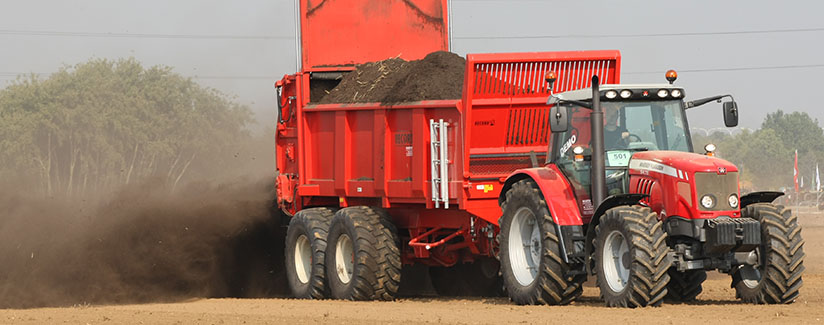
“Large farms are bad for the environment.”
The Skinny
Manure from farm animals when used as fertilizer improves soil and increases crop yields. It can become a pollutant if it reaches water supplies.
Farm animal production in the United States has clearly shifted away from many small farms to an increasing number of larger farms. It takes several small farms to equal the manure production of a single large farm. On the large farm, the manure management responsibility lies with only one management system instead of several.
Research shows larger farms use more comprehensive manure management practices than smaller farms. Larger farms must comply with stricter regulations than smaller farms and are often more able to employ people or hire consultants who specialize in manure management issues.
Research also suggests that large farms as a group may practice better manure management than smaller farms as a whole.

Robert Burns, PhD says:
In fact, data collected to date suggests that large farms as a group may practice better manure management than smaller farms as a whole.
Over the past four decades the number of livestock and poultry farms in the United States has decreased while the number of animal units produced has increased. The USDA Economic Research Service reports that between 1982 to 1997, the number of farms in the United States with confined animals decreased by 51% from 435,000 farms in 1982 to 213,000 farms in 1997. During this same period however, the number of animal units (where one animal unit is defined as 1,000 lbs of live animal weight) increased by 10% (Gollehon, et al, 2001). The overall decrease in farms with confined animals was due to decreases in the number of farms classified as very small or small in size. At the same time, farms classified as medium and large increased in number. During this period, the number of farms with over 1,000 animal units doubled in the United States. It is important to note that the increase in animal numbers during this period was due to an increase in the number of large farms, and not an increase in the size of large farms. Plainly stated, the clear trend in the US is that animal production has shifted away from many small farms to an increasing number of larger farms.
The reorganization of the US livestock and poultry sector away from smaller farms and into larger farms raises the question; are large farms bad for the environment ? A by-product of any animal production farm is manure. Manure contains both organic matter and nutrients. When manure is applied at agronomically appropriate rates as a crop fertilizer, it increases biological activity in soils, improves physical soil properties and provides valuable nutrients required for crop production. The environmental benefits associated with land application of manures are well documented and include increased soil water and nutrient holding capacity, increased water infiltration, improved soil aeration and reduced soil erosion (CAST, 1992). The ability for manure to become an environmental pollutant when it is released into waterbodies or the atmosphere is equally well documented. The organic matter, nutrients, bacteria and salinity in manure can become an environmental pollutants if they are allowed to reach surface and groundwater supplies (CAST, 1992).
To compare the potential environmental impact of small or large farms, the management of the manure by the farm must be considered. Manure becomes an environmental pollutant if it is miss-managed and allowed to enter streams and waterbodies. As such, the proper management of manure is of critical importance. If we compare a single small farm to a single large farm, it is clear that the larger farm will produce a greater amount of manure. It is the management of the manure on a given farm that determines if the manure is an environmental benefit or determent however. For the same level of animal production however, one large farm and several small farms will produce the same amount of manure. On the large farm the management responsibility lies with one farm for all of the manure, while for the same production level by several smaller farms, the management of an equivalent amount of manure would be distributed between several smaller farms.
Based on a survey of 391 Minnesota swine producers of various sizes, it was found that farm size had a statistically significant effect on manure management practices (Schmitt, et al, 1996). This peer-reviewed study reported that the level of manure management implemented on the farm increased with farm size. The study found that as farm size increased, so did the frequency of analytical testing to determine manure nutrient values, manure application equipment calibration, application during the appropriate time, sub-surface injection increased over broadcast spreading and manure application record keeping increased. The study findings indicate that larger farms implement more comprehensive manure management practices than smaller farms. If we consider the regulatory structure in place for animal feeding operations, the findings of the Schmitt study are not surprising. The storage and land application of manure is regulated on larger livestock and poultry farms. In addition to the fact that large farms must comply with stricter regulations than smaller farms, larger farms are more often able to employee personnel, or contract with consultants, who specialize in manure management to better address manure management issues.
In summary, while manure from any size livestock or poultry operation has the potential to be an environmental pollutant if miss-managed, it also has the potential to replace inorganic fertilizer and provide environmental benefits when managed correctly. As such, it is not farm size that determines if a livestock or poultry operation has a good or bad impact on the environment, but rather it is the management of the manure generated by a given farm. Well managed large farms with good nutrient management plans in place and that comply with state and federal regulations are just as sound environmentally as several small animal production farms that produce a similar number of animals. In fact, data collected to date suggests that large farms as a group may practice better manure management than smaller farms as a whole.
References:
Council for Agricultural Science and Technology (CAST). 1992. Water quality: Agriculture’s role. CASTRep. 120. Ames, IA.
Gollehon, Noek, Margriet Caswell, Marc Ribaudo, Robert Kellogg, Charles Lander, and David Letson. 2001. Confined Animal Production and Manure Nutrients. Agriculture Information Bulletin No. (AIB771) 40 pp, June 2001. Economic Research Service, USDA.
Schmitt, M. A., D. R. Schmidt, L. D. Jacobson, 1996. A Manure Management Survey Of Minnesota Swine Producers: Effect Of Farm Size On Manure Application. Applied Engineering In Agriculture. Vol. 12(5):595-599

Larry Jacobson, PhD says:
The statement that large farms are bad for the environment is misguided but for air quality this statement is plausible.
Are large farms bad for the environment?? If one listens only to the general public print and broadcast media sources, you would probably say yes. However, if one takes a more in depth and scientific look at size (# of acres and/or animals owned and operated by a single farm) only, there are valid arguments that large farm are no worse at harming the environment than small farms.
First of all, let’s define large farms. Turns out that this is not an easy question to answer. The average farm size by area from the latest National Agricultural Statistics Service (NASS) report (Feb, 2008) is 418 acres. However, for the U.S., this farm area size varies greatly by state from 2,700+ acres in Montana to 57 acres in Rhode Island. So a large farm in one of the Northeastern states (say 500 acres) would be a small farm in one of the western states!!
For animal production operations, it may be a little easier to define what might be considered large. The Environmental Protection Agency (EPA) has come up with a common unit to “size” livestock and poultry operation that is called an animal unit (AU). This is defined as 1000 lbs of animal live weight. So a 1000 lb beef steer would be one AU while four 250 lb pigs (4x 250 lbs = 1000 lbs) would also be one AU. The EPA has defined a Confined Animal Feeding Operation or CAFO, as a farm having 1000 AUs, which the animal production industry, regulatory community, environmental groups all defines as large.
There are other criteria that might be used. Again the NASS report divides up the U.S. farms into economic (annual) sales classes. These are between $1,000 and $10,000, between $10,000 and $100,000, between $100,000 and $250,000, between $250,000 and $500,000, and finally those farms that have annual sales > $500,000. In 2007, the NASS report estimated there were 1.22 million farms in the first economic class (between $1,000 and $10,000) while there were 126,000 farms in the fifth class (> $500,000). These are gross sales figure and most economists would estimate that nearly all farms only would have net or profit figures from 10 to 30 % of their gross receipts, so if someone wants to be a full-time farmer they will probably need to have sales at least above $100,000 and possibly over $250,000, especially if they have debt to service and want a reasonable living expense for themselves and their families.How about the question of impacting the environment? Production agriculture operations or farms could impact the environment by degrading the nation’s soil, water, or air. Let’s look at each separately.
Production agriculture uses soil as one of its main resources to produce food (plants directly and animals indirectly). Crops remove nutrients and they must be replaced to maintain a sustainable soil system. Also, some cropping practices (and maybe some animal grazing practices) may promote soil erosion through water or wind forces. So soil can be degraded by excessive nutrient removal (mining) and/or soil erosion. Almost every farm, large or small, will maintain the soils nutrients by the addition of natural (cover crops), organic (animal manure), or chemical fertilizers otherwise it will not produce the crops planted. Similarly, soil conservation practices such as contour farming, wind breaks, and vegetative buffer strips are practiced or built on both large and smaller farms. I’m not aware of a breakdown by size of farms from the Natural Resource Conservation Service (NRCS) on who receives cost share funding to implement the soil conservation practices mentioned above but I think it is farms of all sizes and might even favor larger farms. Therefore, I believe the statement that large farms are bad for the environment as pertaining to impact on the nation’s soil is misguided.
Obviously, farms need lots of water, either if they raise crops or produce animal products. Larger farms may need to draw from either surface or ground water sources to irrigate crops or water livestock or poultry so they may locally impact the quantity of water more than smaller farms, but when expressed on a per unit of production (bushel of crop or lb of milk or meat) this would not be different than for small farms. So barring some very local situations, the perception that large farms are bad for water quantity is also misguided.
The situation for water quality is more complicated. Larger farm certainly have greater potential to negatively impact water quality no matter if they produce only crops (larger fields and probably a higher usage of commercial fertilizers and other chemicals than smaller farms). However, on the positive side, large farm often participate in more conservation programs that reduce erosion (runoff to surface waters). Large farms often have more modern and high-tech machinery that practice so-called precision farming (apply only the fertilizer and herbicide/pesticide needed by the crop / land). Small farms, because of smaller equipment and fields may leave existing vegetative buffers along fence rows and windbreaks that would restrict field runoff. Conservation practices that are advocated by such governmental service as the NRCS are available to all size operations but do have funding limits that might restrict implementation on large farms.
For animal operations, large farms (>1000 AU) are required by EPA regulations to have nutrient management plans (NMP) which forces them to apply their animal manure produced on these operations at agronomic rates based on nitrogen (N) or in some cases phosphorous (P) levels in the manure onto cropland (their own or to someone they have a contractual agreement). Depending on the state, some smaller livestock farms under 1000 AU are also required to develop and use NMP but most states these are not required for small farms (< 100 or 50 AU). Thus, although they again have potential to impact water quality, because of regulations and the large financial incentive to use this resource (animal manure) wisely, the perception that large farms (crop or animals) have a greater negative impact on water quality is again misguided.Finally the issue of air quality. Here, I believe large farms, especially animal operations, have a problem (Jacobson, 2007). Because large CAFO’s concentrate animals in a single location they often produce large single source emissions of gases, odors, and particulates from the animal buildings and any associated manure storage / treatments systems. These can have local (odor), regional (acidification of vegetation and surface waters), and global (climate change) impacts. Most damaging of these are the local and regional impacts since the global (greenhouse gases – GHG) effects would be cumulative even for small farms. Small livestock and poultry operation will also produce emissions but typically are sufficiently low that their impact is considerably less on the environment. Also, crop farms can impact air quality by the emissions of particulates or dust from fossil fuel sources such as tractors, irrigation engines, or through tillage practices. Mitigation technologies are being developed to reduce air emissions from animal operations and even crop farms, but these are expensive and typically need more developmental work before they become commonly used on farms. So at this time, when it comes to air quality issues, I believe the statement that large farms are bad for the environment is plausible.
In summary, for soil and water quality components, I believe the statement that large farms are bad for the environment is misguided but for air quality this statement is plausible.
References:
National Agricultural Statistics Service (NASS) report (Feb, 2008). Farms, Land in Farms, and Livestock Operations 2008 Summary (available on web).
Environmental Protection Agency website ( “http://cfpub.epa.gov/npdes/afo/info.cfm“). “General Information on Concentrated Animal Feeding Operations”
Jacobson, Larry D. (2007) ‘Animal Structures: Air Quality’ Encyclopedia of Agricultural, Food, and Biological Engineering, 1:1, 1-3, DOI: 10.1081/E-EAFE-120007233.
“1DM39229” by werktuigendagen is licensed under CC BY SA 2.0.



























